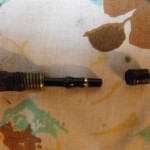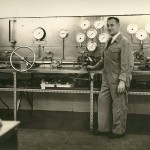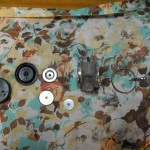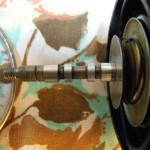Hey guys.
Long time since I posed here, so thought it was time I got my act together and wrote something.
Welcome to Workshop De La Cameron.
I just spent the last half hour or so mucking around with a height corrector for a young chap from www.oldschool.co.nz’s potential new purchase, so I thought mid way through that I should take a few pics of what goes on inside a component of one of the most unjustifiably feared vehicular systems that anyone could hope to own.
It baffles me as to why people pay ultra huge money for this shit to be worked on by mechanics. yesterday I met a guy who had been, for want of a better phrase, bent over the bonnet of his Citroën and bottomed. His wallet didn’t fare too well in the escapades either, I’m led to believe. The issue he sent his car in for wasn’t rectified either, so he’s gained nothing.
It happens every day, and meanwhile there’s a million other ‘generic’ garages, or home handymen out there that turn away simple problems with their customer’s, or their own cars, as they’re daunted by something little more complicated than a basic electrical circuit, the main difference being, the cables don’t carry tickly sparking stuff, instead, a pugent smelling, psychedelic on ingestion, liquid of enchantment and despair.
Anyway, I digress.
This height corrector came off a perfectly functioning rear suspension in a 1991 BX14 that I stripped for parts a couple of months ago. I’d only pulled it to bits to make sure everything was as it should be, and to ensure that there was a very low chance of any problems arising upon fitting the unit to another vehicle.
Height correctors are essentially all the same across the range, only pipe sizes seem to have changed from 1960. I guess they may be electronic on some of the later models too but I’ve not dealt with them before.
Anyway, some pictures.
This is the article in question.
The ball joint at the end is where the linkage system hooks to it. From there the linkages are hooked usually to the centre of the swaybar of the suspension group. As the suspension moves, the linkage moves, telling the height corrector what needs to happen. If you add weight to the car, the suspension will compress. The height corrector recognises this and adds fluid to the suspension units, bringing the car back to the original height.
Lose weight, suspension rises, corrector dumps fluid back to the tank and the suspension drops. Simple!
The Webs at the top and bottom of the corrector have ports in them where the pipes screw into. the small rubber pipe is a leak off return pipe. I’ll explain this in a little more depth later.

This is a section of pipe. Similar to a ‘normal’ bundy tube flare type joint as found on most other cars’ braking systems with one differnce. That little sleeve on the right.
All steel piping in Citroen hydropneumatic suspension/brakes/steering systems have these types of joints. Teh sleeve is made of rubber and is inserted into the female side of the joint, then the pipe goes in after it, the nut is tightened over the top and sealing is done. Pretty interesting way of doing it. It allows some movement of the pipes when tightened.
Not much inside really. The most interesting bit is the notched shaft hooked to the aformentioned ball joint at the right hand side
Movement of this opens and shuts two ports. One is a return to tank line, the other is high pressure feed. When the car’s too low, the high pressure one is open and lets fluid through to the outlet pipe on the opposite side of the corrector, thus, feeding the suspension units and lifting the car.
When the suspension’s too high, the inverse happens, and fluid is returned to the tank. easy!
When the height’s just right, both ports are closed, letting you glide on a cushion of lushness/green fluids.
Heres a close up of said shaft
And a shot showing the guts of the height corrector where the shaft runs, and the supply and return ports.
The hole on the right hand side of that last shot goes right through to the other side, and joins up to the little rubber hose things that I mentioned earlier.
As you may have noticed, the shaft in the middle has no rubber seals on it. So how does the valve just not bypass and otherwise leak everywhere?
Here’s where I plagiarize someone else’s writing.
From John Reynold’s book “Original Citroën DS”
‘In order to minimise friction in the most sensitive slide valve or piston units, it was essential to avoid the use of seals or gaskets that would restrict the flow and prevent excess bypass of fluid. Although the pipe system itself would be fully sealed against leaks, the proper operation of the pistons and slide valves would have to be achieved entirely by ensuring precision fit within the bores., allowing jsut enough room for movement but no more. A certain amount of fluid would be permitted to pass so as to lubricate the moving parts. ‘
‘The machining of the adjacent metal surfaces in the slide valves and pistons would have to be perfect, to give clearances of between 1 and 3 microns, a degree of acuuracy never achieved before in any area of industrial mass-production except in the field of diesel-injection equipment. Before the DS19 could be produced, Citroën would have to perfect a completely new high-precision metal working thechnology involving extremely sophisticated plant and machinery capable of working to one tenth of a micron (0.0001mm or 0.000004in). and since this expertise did not exist, Citroën would have to develop it’s own techniques reachign the very limits of mechanical precision, and to become virtually self-sufficient in micron-standard manufacturing.’
Basically, to do away with rubber seals, and to self lubricate components, they machined everything to super high tolerances, letting each component leak a little to lubricate itself. This ‘leaked off’ fluid is caught in rubber boots, and sent back to the reservoir in a spaghetti of low pressure return lines.
Most leaks in Citroën hydraulic systems can be attributed to these low pressure lines sustaining damage from foreign objects or the rubber and plastic material succumbing to age and breaking/perishing/splitting.
for a little more info on the rest of the workings see here
http://www.citroenet.org.uk/miscellaneous/hydraulics/hydraulics-1.html
Anywho, hopefully you’ve all remained conscious whilst reading this.
Cheers,
Cam.







young chap – snortle..
Hey Cam
Farrrrrrrk, thought this was Ky to start with. Still wanted to slit my throat regardless
you goat eliot. hah.